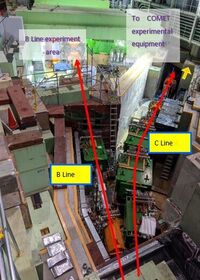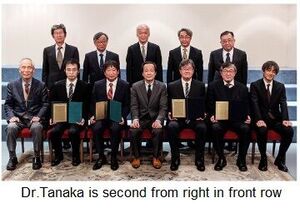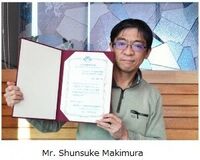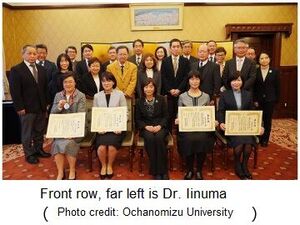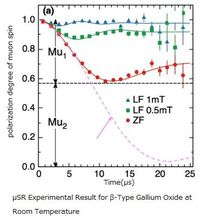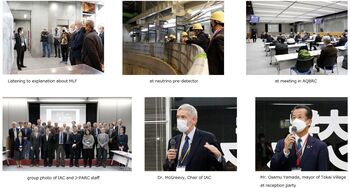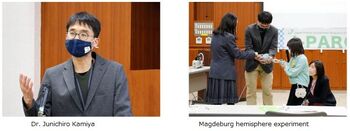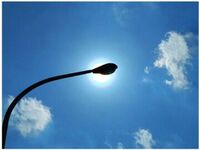J-PARC News April 2023 (Issue #215)
■"C-Line" at Hadron Experimental Facility Completed (March 14)
The construction of the "C Line", the third primary proton beamline at the Hadron Experimental Facility, was completed. The C Line is a beamline branching off from the existing B Line and provides a proton beam accelerated to 8 GeV for the COherent Muon to Electron Transition (COMET) experiment. On February 9, 2023, beam commissioning of the C Line started. After the facility inspection by a third-party organization on March 14, the change of the license as a radiation facility was officially approved on March 15.
The COMET experiment aims to search for a very rare process, muons-to-electron conversion without neutrino emission. Using the high-intensity proton beam at J-PARC, it is possible to produce large quantities of muons. This experiment will be the first in the world to find this reaction. The secondary muon beamline was also commissioned in parallel with the primary proton beamline. With the completion of the C line, the COMET experiment is expected to make significant progress.
■Dr. Kazuhiro Tanaka Receives Suwa Award
Dr. Kazuhiro Tanaka of the Hadron Section has received the Suwa Prize for 2022 from the Foundation of High Energy Accelerator Science for his achievements in the development of radiation-resistant electromagnets for high-intensity accelerator facilities. This prize was established to honor the contributions of Dr. Shigeki Suwa, the first director of the High Energy Accelerator Research Organization, and is awarded to scientists, engineers, research groups, and project groups who have made particularly noteworthy contributions to the development of high-energy accelerator science.
For more information, please visit the KEK website. https://www2.kek.jp/ipns/ja/news/4232/
■Mr. Shunsuke Makimura Won Best Presentation Award for Applied Research
At the Science Academy of Tsukuba (SAT) Technology Showcase 2023 held at the Tsukuba International Congress Center, Mr. Shunsuke Makimura in Hadron Section won the Best Presentation Award for Applied Research for his exhibit on "Industrial Innovation with Advanced Accelerator Technology - Toughened Fine-Grained Recrystallized and high electrical resistivity tungsten alloy.” Mr. Makimura has been developing tungsten alloys to improve the performance of a pion-production target for COMET experiment at J-PARC. This time, he presented the progress in developing the tungsten alloy with high electrical resistance under interdisciplinary collaboration for industrial application. For more information, please visit the KEK website. https://www2.kek.jp/ipns/ja/news/4036/
■Dr. Hiromi Iinuma Wins Silver Prize of "Toshiko Yuasa Award”
Dr. Hiromi Iinuma of the Graduate School of Science and Engineering, Ibaraki University, has received the Silver Prize of the 2022 “Toshiko Yuasa Award” for her achievement in "Development of an experimental method for both two fundamental physics quantities: precise measurement of muon anomalous magnetic moment and direct search for electric dipole moment.” Dr. Iinuma conducts experiments at the MLF of J-PARC.
For more information, please visit the KEK website. https://www2.kek.jp/ipns/ja/news/4063/
■Understanding Metastable State of Hydrogen that Influences Characteristics of Power Semiconductor β-Ga2O3
- Approaching "Two Faces" of Trace Amounts of Hydrogen in Materials -
Research on gallium oxide is being advanced as a candidate material for next-generation power semiconductors that are low-loss and high-efficiency toward realizing a low-carbon society. If it is put into practical use, it will be possible to create inexpensive devices with higher performance than silicon. To this end, precise control of electrical properties is essential, and understanding the main factors affecting these is necessary. Especially, gallium oxide can contain hydrogen as an unintentional impurity in manufacturing processes, which may change electrical properties significantly. However, there are a few direct methods for investigating trace amounts of hydrogen, and experimental findings have been limited.
A research group from Ibaraki University, Tohoku University, KEK, NIMS, and Tokyo Institute of Technology conducted detailed study on the local electronic state of muons(µ⁺)as "pseudohydrogen" implanted into β-gallium oxide (β-Ga2O3) by the muon spin rotation/relaxation (µSR ) measurement using ARTEMIS, general purpose µSR spectrometer, at MLF in J-PARC. As a result, it was found that the muons take two metastable states playing the donor-like and acceptor-like roles of electrons. In particular, an acceptor-like state was revealed for the first time using high-statistics data from the high-flux beam at J-PARC, which supports the recently proposed "ambipolarity model."
This finding is expected to provide important guidance for materials development and serve as a starting point for realizing smaller, higher-performance power semiconductors.This research achievement was published as a Letter in the US science journal Physical Review B on January 18th.
For more information, please visit the J-PARC web site.https://j-parc.jp/c/press-release/2023/02/06001106.html
■ International Advisory Committees Held
1) Muon Advisory Committee (MAC) (February 20-21, J-PARC and online)
The status and plans of the MLF muon experimental facility (MUSE) were reported. The progress of each beamline/instrument and the development of human resources in the section were reported. The committee highly appreciated them and recommended to the MUSE management to draw up a long-term vision/road map for the future development of the facility.
(2) International Advisory Committee (IAC) (February 24-25, AQBRC※and online)
The International Advisory Committee (IAC) in FY2022 was held to evaluate the overall performance of J-PARC Center, such as a good balance of user program and facility improvements, and the future vision of the facility. The meeting was canceled in 2019 due to the COVID-19 pandemic and was held remotely in 2020 and 2021. This year, the IAC was held in person, and the J-PARC staff were able to interact directly with each committee member. At the end of the committee meeting, Dr. McGreevy, Chair of the IAC, presented the findings and draft recommendations of the IAC. While there were concerns about the limited operating hours due to soaring electricity prices, the committee was very appreciative of the J-PARC's activities.
※AYA'S LABORATORY Quantum Beam Research Center
■Quantum Beam Science Festa 2022 Held (March 13-15, Tsukuba International Conference Center and online) with the 14th MLF Symposium and the 40th PF* Symposium
Quantum Beam Science Festa is held annually under the auspices of the KEK Institute of Materials Structure Science, J-PARC Center, Comprehensive Research Organization for Science and Society (CROSS), PF Users Association (PF-UA), and J-PARC MLF Users Society.
The MLF symposium was held online and was attended by approximately 290 participants. During the symposium, the reports on facilities and future plans were presented, and a general meeting of the MLF Users Society was held, followed by an exchange of views on the results of a user questionnaire survey.
For the first time in a long time, the Quantum Beam Science Festa was held face-to-face and was attended by about 400 people. There were two keynote lectures, six parallel sessions, and about 230 poster presentations, where the keynote lectures were broadcasted online and were attended by more than 100 accounts. In the PF Symposium, beamline upgrading, and future plans were presented.
※KEK Photon Factory
■J-PARC Hello Science "Story of Vacuum Aiming Toward Complete Empty" Held on February 24th
In February's Hello Science, Dr. Junichiro Kamiya of the Accelerator Division Section Ⅲ served as a lecturer.
The concept of vacuum has a history of over 2,000 years since the ancient Greeks. The peripatetic thought "horror vacui," meaning "nature abhors a vacuum," dominated the European view of nature until the birth of modern science. However, the existence of a vacuum was proven by a series of experiments in the 17th century. At this month’s Hello Science, one of those experiments, the Magdeburg hemispheres experiment, was performed with the participants.
Even in an ultra-high vacuum, there are numerous molecules in space. Most of the molecules are absorbed on the wall surface inside an ultrahigh vacuum chamber and desorb to the vacuum. At the J-PARC, ultra-high vacuum was achieved in most of the beamlines in the case without a beam. However, when the high-intensity beam operation starts, the pressure in the beamline rose by about 1,000 times. Therefore, by installing NEG pumps (non-evaporable getter pumps), increasing the pumping speed, and suppressing the number of molecules adsorbed on the walls, the pressure increase was successfully suppressed as expected.
Recently, a gas sheet beam monitor was developed using vacuum technology. The cross-sectional shape of the J-PARC beam was visualized. This beam monitor may have potential applications in medical accelerators. In addition, as a contribution of J-PARC's vacuum technology to industry, a technology for making a titanium vacuum chamber a vacuum pump by giving it a getter property (the ability to adsorb/absorb gases), was developed and patented. As a future development, J-PARC aims to apply this technology to ultra-high vacuum transfer cases, which may be useful for transporting new material samples for semiconductor chip research in a vacuum.
■Sanpo-michi#33 Pollen and Neutrinos
There is a lot of cedar pollen in the air right now. Looking up into the sky at J-PARC, we can see a pollen corona, where pollen particles separate the color of sunlight.
The pollen is tens of microns in size, smaller than the diameter of a human hair, and cannot be seen with the naked eye. However, the pollen is numerous, with more than 1,000 pollen per 1㎠ observed in some cases. The wind sometimes blows light and numerous pollen more than 100 kilometers. However, the probability of pollination is very low. Only a tiny percentage of them will grow into the tallest and longest-lived giant trees in Japan.
Neutrinos are the second most abundant particles in the universe if you consider light t particle, and J-PARC produces an enormous number of neutrinos, ten quintillions (1019) per day, which are flown to Super-Kamiokande, 295 km away. Of these neutrinos, only one trillion (1012) can enter the giant water tank at Super-Kamiokande, and only a few are detected in the giant water tank in a day.
Nevertheless, the information from a few reacting neutrinos per day can provide clues to the mass of the entire universe and the reason for the disappearance of antimatter that existed at the time of the universe's creation. The neutrino facility at J-PARC is being modified to efficiently produce and send out more neutrinos to further explore the mysteries of the universe.

